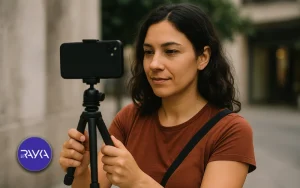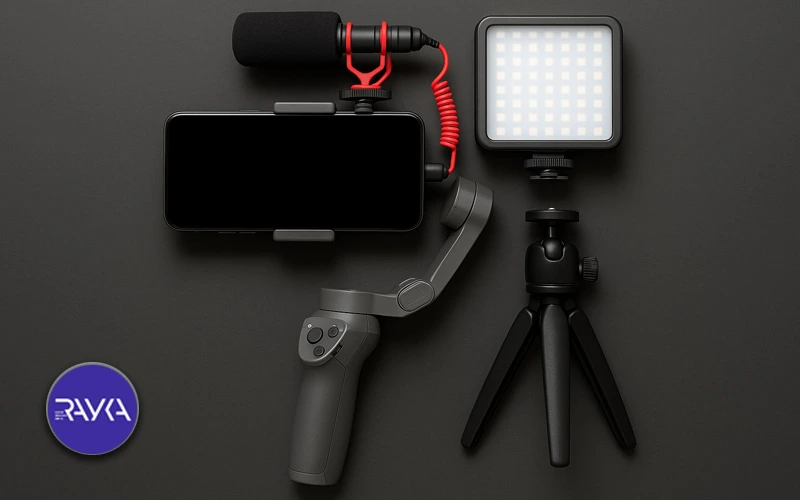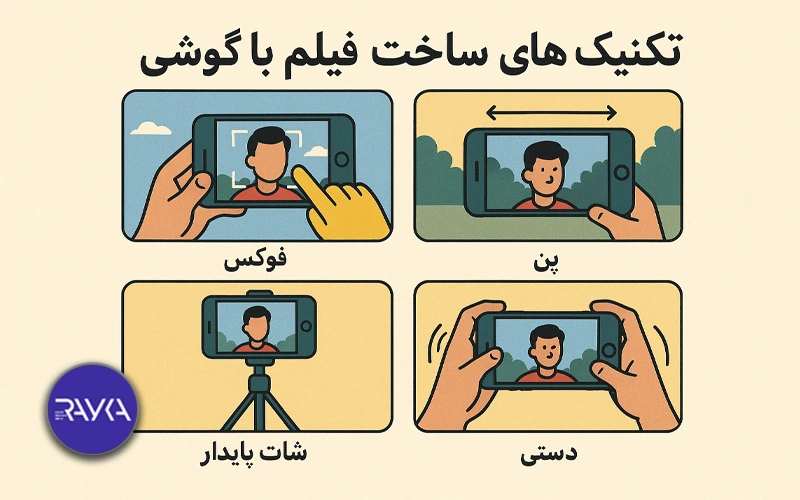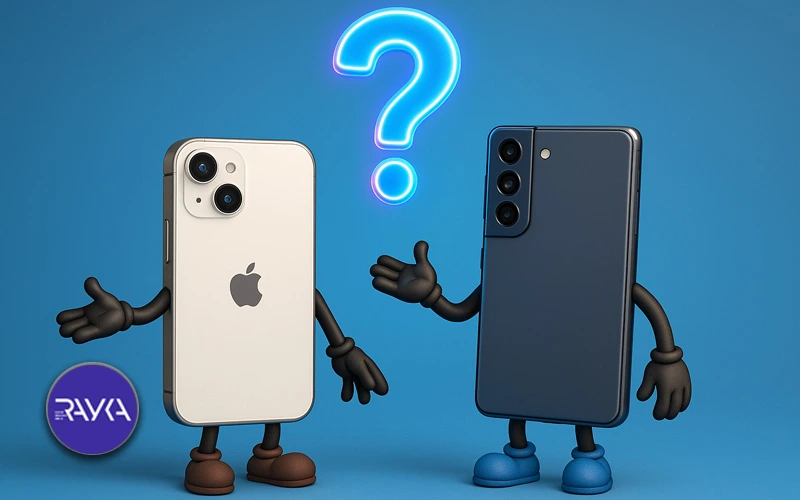
Making films and videos with a smartphone is no longer just a simple hobby. Many independent filmmakers now use these small devices to produce professional content. Modern smartphones have advanced so much that their image quality and software capabilities often rival professional cameras.
A few years ago, only major directors could produce cinematic films. Today, anyone with a powerful smartphone, some creativity, and basic accessories can bring their stories to life. In this guide, we’ll show you how to turn your phone into a complete filmmaking tool, which techniques to use, and how AI can help create engaging projects.
Smartphone filmmaking means using a mobile device to handle all stages of video or narrative film production. It’s not just about recording video; the phone becomes a tool for shooting, recording audio, editing, and even publishing.
Many people think mobile filmmaking is only for social media, but that’s not true. Numerous professional projects — from documentaries and short films to independent feature films — have been shot entirely on smartphones. For example, the well-known film Tangerine was filmed on an iPhone and received international acclaim.
If your goal is to tell a compelling story or produce a professional video, a smartphone can perform tasks that previously required expensive equipment.
Before starting, equip your phone with professional accessories to improve image, sound, and stability. Key tools include:

Yes, shooting professional, feature-length films on a smartphone is now fully possible. Modern devices support 4K and even HDR recording, suitable for large-screen display.
Unsane by Steven Soderbergh is a notable example of a feature film shot entirely on an iPhone, proving smartphones can be serious tools for long-form storytelling.
For longer projects, keep in mind:
To produce professional mobile videos, follow these key techniques:
Lighting is the most important factor affecting image quality. Use natural light when possible and modify it with diffusers, fabrics, or reflectors. Proper lighting makes details clear and visually appealing.
Hand shake reduces video quality. Use a tripod, gimbal, or even simple supports to keep footage steady and cinematic.
Apps like Filmic Pro allow precise control over exposure, focus, and shutter speed. Manual adjustments result in brighter, sharper images and avoid unwanted motion blur, especially in challenging lighting.
Clear, noise-free audio is essential. Use an external microphone for mobile devices and shoot in quiet environments. If that’s not possible, minimize background noise.
Proper framing directs viewer attention to the subject. Simple rules like the rule of thirds and varying angles create professional-looking shots. Changing the frame throughout the video adds visual dynamism.
Controlled movements, such as gradual zooms or gimbal pans, give a cinematic feel. Sudden jerks or shakes can confuse viewers and reduce engagement. Planning camera movement improves storytelling.
Post-production editing and color grading are vital. Mobile apps allow precise cutting, color adjustment, and visual effects. Correct color grading creates a cohesive, polished look that captures audience attention.

Both smartphones and professional cameras have pros and cons. Smartphones are portable, compatible with accessories, and support advanced apps, making them ideal for fast, affordable content creation. Professional cameras, however, provide higher image quality, precise control over lighting and depth of field, and more advanced audio recording options.
| Feature | Smartphone Filmmaking | Professional Camera Filmmaking |
|---|---|---|
| Image Quality | Suitable for 4K and high-quality recording, but limited by a smaller sensor | Very high quality, larger sensor, and greater depth |
| Portability & Ease of Use | Very lightweight, portable, and easy to use | Heavier and requires more technical knowledge |
| Manual Settings | Limited, but adjustable with apps | Full control over exposure, focus, ISO, etc. |
| Cost | Low-cost and affordable | High cost for equipment and accessories |
| Accessories | Gimbals, external lenses, and mobile microphones | Various lenses, professional microphones, and extensive lighting |
| Audio Quality | Acceptable with external microphone | Excellent quality with professional equipment |
| Limitations for Long Recording | May be limited due to heat and battery | Suitable for long recordings and complex projects |
Artificial intelligence has become one of the biggest transformations in the film industry. Today, smart tools can handle various stages of film production creatively and quickly. From scene design to editing, all these processes have become simpler with AI-based software.
For example, tools like Runway ML and Pika Labs allow the production of short and even long videos using simple text and commands. You can also use AI models to modify actors’ faces or perform professional voiceovers. This technology reduces costs, speeds up production, and makes content creation easier for independent filmmakers.
AI has remarkably transformed the filmmaking process. Despite the advanced capabilities of AI software, the director’s creativity, artistic vision, and human presence still play a vital role in making a successful film. These tools can simplify and accelerate editing, color correction, and even initial drafts, but ideation and project direction require your experience and creativity. Familiarity with these technologies is a crucial step toward becoming a more professional filmmaker.
Rayka Mah, with specialized experience in AI-powered cinematic film and video production, helps you bring your creative ideas to life in the best possible way. If you want to learn more about Rayka Mah’s services or get a free consultation, fill out the form below to have our experts contact you.
In many filmmaking styles, a smartphone is not just a cost-effective alternative but often a faster and more flexible option. Even for projects such as photo-based filmmaking or compact documentaries, a mobile phone can play a significant role. If you plan to work in one of the following styles, a smartphone may be your best tool:

The choice between iPhone and Android depends on your needs and budget. Each has advantages and limitations that should be carefully considered before starting a project. Here are the key points:
IPhones are known for advanced image processing and stable performance in filming. Dedicated apps like FiLMiC Pro and iMovie work smoothly on iPhone, delivering consistent and reliable video output. If you want the simplest path to professional videos with minimal software hassle, iPhone is an excellent choice.
Android offers a wide range of devices and hardware features. Some Android models, like Google Pixel or Samsung Galaxy, provide high-quality video recording. If you have a limited budget or want features like expandable storage, removable batteries, or multiple lens options, Android is a suitable choice.
If your primary focus is consistent image quality and software speed, iPhone is worth the investment. If flexibility, device variety, and additional features matter more, a flagship Android phone can be a great option. Before deciding, compare sample videos recorded on both devices to ensure they meet your needs.
Creating films and videos with a mobile phone is no longer just a temporary or low-budget solution; it is now a professional and creative choice. With the right tools, proper techniques, and a bit of creativity, your smartphone can become a small filmmaking studio.
Whether producing documentaries, social media content, or short artistic films, a mobile phone allows you to start quickly, efficiently, and at low cost. New technologies, including AI, further help simplify technical steps and enhance professional quality.
If you need guidance to get started or want to enter a more professional filmmaking world with expert support, the Rayka Mah team is ready to assist you.
Yes, many festival films and professional productions have been created with smartphones. The output quality depends on the phone model and your skills.
FiLMiC Pro is popular for professional shooting, while Kinemaster or InShot are widely used for video editing.
Yes, if you use proper lighting and external accessories like a microphone, mid-range phones can also produce high-quality videos.
The main limitations are depth of field control, raw sound quality, and restricted lenses. These can be reduced with additional equipment.
Yes, in addition to producing professional content, Raykamah specializes in AI-powered filmmaking. Our team can execute your film projects using innovative and modern technologies.